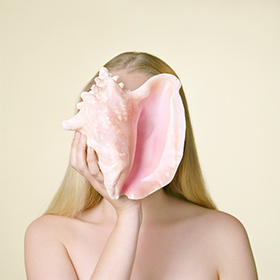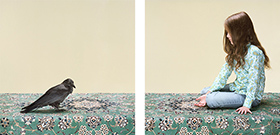Petrina Hicks - The Shadows
Rather than using her camera to capture an image of the world, Petrina Hicks creates a world for her camera. Within her studio, she assembles sculptural forms with a meticulous eye for detail - the shape of a vase, the fall of fabric, the pinkness of a shell. Her subjects, whether people or objects, are loaded with symbolism and exist within a strangely placeless reality, making them hard to pin down. In her recent profile on Petrina Hicks’ writer Carrie Miller describes this process as one of ‘seductive subversion’, combining heightened technical skill and elegant compositions with an unsettling ambiguity.
In The Shadows Hicks continues to seduce and subvert. She draws attention to habitual ways of thinking and depicting in our culture, past and present. A particular focus for Hicks is the depiction women. In Venus, for instance, a model obscures her face with an enormous and elaborate shell. This imagery recalls Botticelli’s Birth of Venus in which the feminine embodiment of sex, beauty and enticement, emerges from a seashell. But in Hicks’ Venus, the shell literally overwhelms the subject, a wry comment on the sexual symbolism commonly associated with women in consumer image culture. In New Age a lump of quartz rests on the groin of a classically posed nude who reclines against richly coloured drapes. Where the symbolism of a crystal, associated in New Age philosophy with power, energy and clarity, meets another in the form of a classical nude, our reading of both is disturbed and distorted. Quietly heightening this disjuncture is a slight bruise on the model’s white thigh that brings us out of the classics and into the present, out of perfection and into reality.
The five newest works comprising Greyscale are a mix of portraiture and still-life. Set against a neutral photographic grey, Hicks presents her subjects as a set of archetypes or perfect forms familiar throughout the history of art. The colour palette in the works – cyan, magenta, yellow and black (CMYK) point to the history of the photograph, especially as a printed object, rather than a screen-based experience. The layering of draped fabric, of figures, vases and fruit within and between the images creates a three dimensional effect, emphasising Hicks’ belief in photography as a material, solid form. The subjects exist somewhere between ‘being’ and ‘object’.


